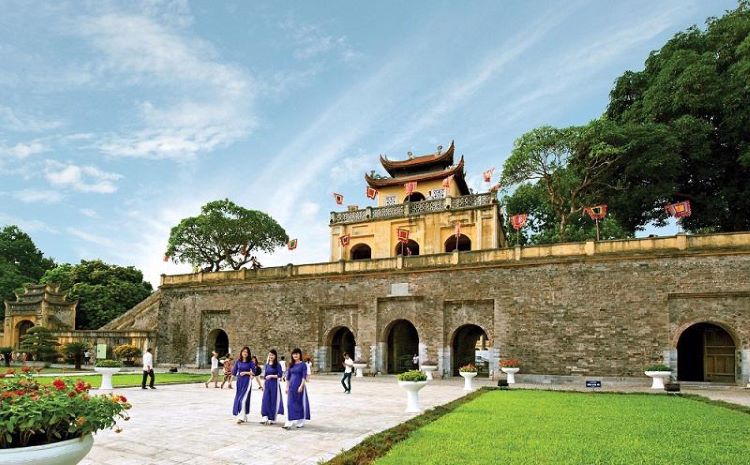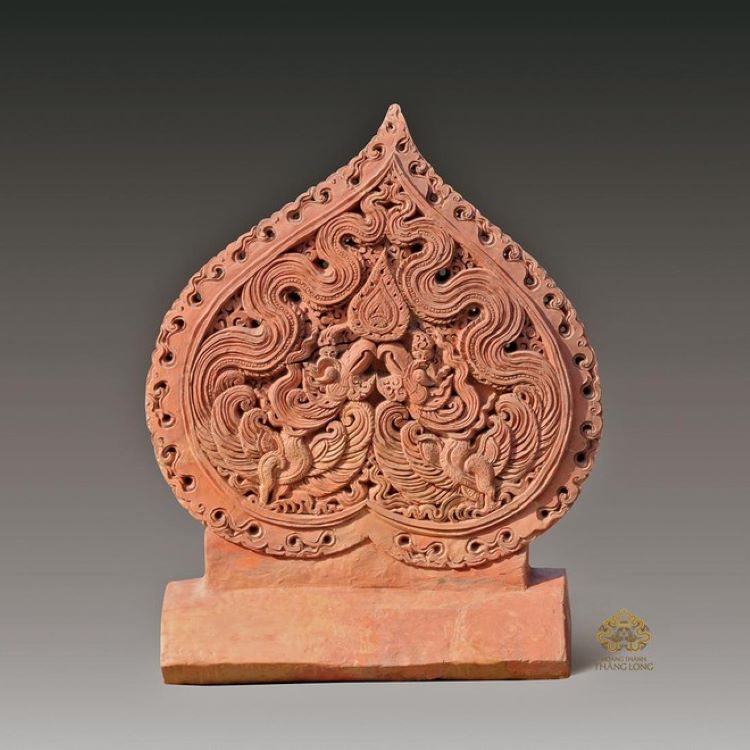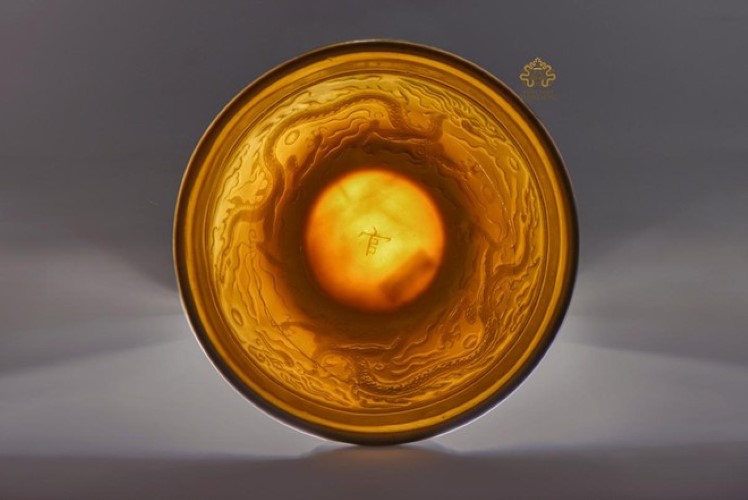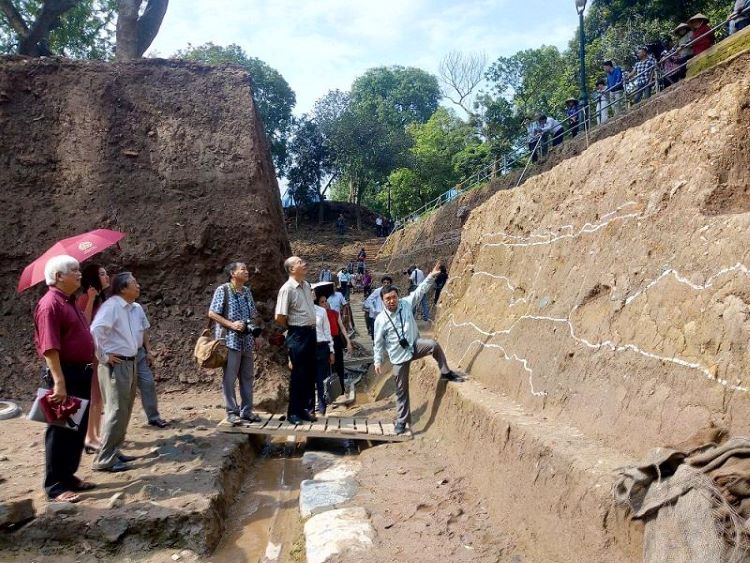The secrets of Thang Long Imperial Citadel’s treasures
The “phoenix-themed Bodhi leaf” and the dragon-themed translucent porcelain bowls are among the most outstanding treasures, showing the outstanding skillfulness of ancient Vietnamese artisans.
Among the 23 newly recognized Vietnamese National treasures list, the “phoenix-themed Bodhi leaf” and two translucent porcelain bowls painted with dragon motif both came from the collection of Thang Long Imperial Citadel.
| Thang Long Imperial Citadel is among the renowned tourist attractions in Hanoi. Photo: Pham Hung |
Sophisticated terra-cotta treasure “phoenix-themed Bodhi leaf”
According to the national treasure record composed by the Institute of Imperial Citadel Studies, the “phoenix-themed Bodhi leaf” is an original artifact, found in pit A20, at the 18 Hoang Dieu Archaeological Site (Ba Dinh District, Hanoi).
“This is one of the most beautiful artifacts found so far that remained almost intact,” the record stated. The artifact consists of the main part and the pedestal. The main part was shaped like a Bodhi tree leaf, and its two sides were decorated with a pair of phoenixes. It is 77cm in height, and the widest part measures 74cm.
Meanwhile, the pedestal has a curved cross-section to fit a type of roof ridge tiles, as reckoned by the researchers. This part is 65.5cm x 34cm wide and 13cm high, with the curved middle 8cm deep and an average thickness of 8cm. When it was first unearthed, the pedestal was broken and some pieces were lost, yet it has now been restored.
Historian Le Van Lan said that the “phoenix-themed Bodhi leaf” is considered to be a perfect work of art.
“The image of the phoenix, in general, has many similarities with peacocks and pheasants. It was the creativity of the sculptors that created the difference and uniqueness to the phoenix image under the Ly – Tran Dynasties,” he stated.
As confirmed by scientists, the treasure “phoenix-themed Bodhi leaf” was made in the 11th century, and is a completely hand-crafted artifact - a single and one-off product, without any similar copy.
| The sophisticated "phoenix-themed Bodhi leaf" artifact showcased the talent of ancient Vietnamese artisans. Photo: Thang Long Imperial Citadel |
According to the Thang Long Heritage Conservation Center, the large-sized Bodhi leaves as roof ridge decorations under the Ly - Tran Dynasties have been discovered in the Imperial Citadel of Thang Long (Hanoi), Long Doi Pagoda (Ha Nam Province), Tam Duong Village (Thai Binh Province), Tuc Mac Village (Nam Dinh Province), Tu Phuc Tomb and Thai Lang Mausoleum (Quang Ninh Province), and Nam Dau Pagoda (Ha Giang Province).
In the Imperial Citadel of Thang Long, there are currently at least four specimens, of which three were decorated with phoenixes and one with dragons. The dragon-themed specimen was discovered in Zone E, including a few pieces of the main leaf part and no pedestal.
Of the three phoenix-themed leaves, beside the specimen that has just become a national treasure, the other two were discovered in pits A20 and A16 within Zone A. These specimens are smaller in size as well as less elaborately decorated than the 11th-century “phoenix-themed Bodhi leaf”, and believed to date from the 13th-century Tran Dynasty.
According to the ancient belief of Vietnamese, the phoenix and the dragon are the symbols of the royal family, in which the phoenix is often associated with the queen, reflecting the existence and blend of Buddhism and Confucianism, the theocracy, and the secular power in the Ly Dynasty’s sculpture.
The three ceramic artifacts, including the “phoenix-themed Bodhi leaf” and two translucent porcelain bowls, affirm the top-notch technique of Vietnamese pottery.
The top-notch technique of Le Dynasty’s porcelain bowls
| The gorgeous translucent porcelain bowl with a dragon motif was founded in the famous heritage site in Hanoi. Photo: Thang Long Imperial Citadel |
The two translucent porcelain bowls painted with a dragon motif are national treasures, regarded by scientists as one of the rarest and most precious royal ceramics in the Thang Long Imperial Palace during the Le Dynasty’s Early Period. This is a discovery of great scientific importance in the history of ancient Vietnamese ceramics, showing solid evidence of the products of the Thang Long court pottery kiln.
The two royal porcelain bowls, with codes A9-2714 and A22-3071, were discovered along with artifacts dating from the Le Dynasty’s Early Period in the 15th-16th centuries, located in the ancient flow filling stratum in the middle of the 18 Hoang Dieu excavation site’s Zone A and Zone B. The filling stratum is covered with a layer of mud formed by the process of sedimentation.
Despite a slight difference in size, the structure, theme, and decoration techniques of the two bowls are the same. Their ceramic cores are as thin as an eggshell, with such high translucency that light can pass through, which shows the high level of pottery technical sophistication in the Le Dynasty’s Early Period.
As researchers of the Institute of Imperial Citadel Studies showed that the most sophisticated pattern of these bowls is the pair of dragons. They are depicted in the posture of flying in the clouds, forming a circle on the side of the bowls in a clockwise direction; in the middle of each bowl is embossed with the letter 官 (Mandarins).
“The dragons’ heads are raised high, the mouths release pearls, the bodies bend into several parts, the tails stretch back like rudders, the fins are also raised high, while the legs are in the movement of kicking the clouds,” scientists said.
The characteristics of the dragons’ bodies, heads, beards, foreheads, horns, eyes, among others are depicted according to the “nine breeds” standard - that is, the dragon has nine characteristics similar to other animals. Their manes lump on the forehead, as well as five-clawed legs, represent the strength and power of the Son of Heaven.
| The ceramic core is as thin as an eggshell, with such high translucency that light can pass through, which shows the high level of pottery technical sophistication in the Le Dynasty’s Early Period (980 - 1005) |
According to the researchers, the word “Mandarins” embossed in the middle of each bowl is reliable proof that rather than offered or imported, the two translucent porcelain bowls were products of the mandarin kiln, or the kiln set up by the Mandarin workshop and specializing in producing utensils for the royal court.
To date, white glazed porcelain bowls with dragon motifs and cores as thin as these two national treasures have only been found in the relic sites of Lam Kinh and Thang Long Imperial Citadel, but in very limited quantities.
At the mausoleums and royal temple of the Le Dynasty in Lam Kinh, viewed as the second capital of the dynasty by many, pieces of white porcelain bowls embossed with the motif of a five-clawed dragon were also dug up. However, all these artifacts were broken, and none has enough pieces to restore their original shapes.
Those two-treasure bowls were made with a transparent printing mold and fired as a single piece at a very high temperature of over 1,250 degrees Celsius, said Bui Minh Tri – Director of the Institute of Imperial Citadel Studies. A transparent printing mold, also called the “flower press” technique – involves using a printing mold to create patterns on the ceramic core before applying the glaze.
This technique appeared at the Thang Long kiln during the Ly Dynasty, bringing new vitality and artistic creativity to Vietnamese monochromatic glazed ceramics.
| Local scientists are conducting a survey at the archaeological site inside the Thang Long Imperial Citadel. Photo: Lai Tan |
















